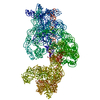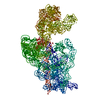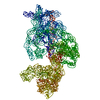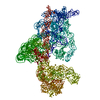[English] 日本語
 Yorodumi
Yorodumi- PDB-3j2b: Dissecting the in vivo assembly of the 30S ribosomal subunit reve... -
+ Open data
Open data
- Basic information
Basic information
| Entry | Database: PDB / ID: 3j2b | ||||||
|---|---|---|---|---|---|---|---|
| Title | Dissecting the in vivo assembly of the 30S ribosomal subunit reveals the role of RimM | ||||||
 Components Components | 16S rRNA | ||||||
 Keywords Keywords | RIBOSOME / Ribosome biogenesis / 30S subunit assembly / RimM | ||||||
| Function / homology | : / RNA / RNA (> 10) / RNA (> 100) / RNA (> 1000) Function and homology information Function and homology information | ||||||
| Biological species |  | ||||||
| Method | ELECTRON MICROSCOPY / single particle reconstruction / cryo EM / Resolution: 13.6 Å | ||||||
 Authors Authors | Guo, Q. / Goto, S. / Chen, Y. / Muto, A. / Himeno, H. / Deng, H. / Lei, J. / Gao, N. | ||||||
 Citation Citation |  Journal: Nucleic Acids Res / Year: 2013 Journal: Nucleic Acids Res / Year: 2013Title: Dissecting the in vivo assembly of the 30S ribosomal subunit reveals the role of RimM and general features of the assembly process. Authors: Qiang Guo / Simon Goto / Yuling Chen / Boya Feng / Yanji Xu / Akira Muto / Hyouta Himeno / Haiteng Deng / Jianlin Lei / Ning Gao /  Abstract: Ribosome biogenesis is a tightly regulated, multi-stepped process. The assembly of ribosomal subunits is a central step of the complex biogenesis process, involving nearly 30 protein factors in vivo ...Ribosome biogenesis is a tightly regulated, multi-stepped process. The assembly of ribosomal subunits is a central step of the complex biogenesis process, involving nearly 30 protein factors in vivo in bacteria. Although the assembly process has been extensively studied in vitro for over 40 years, very limited information is known for the in vivo process and specific roles of assembly factors. Such an example is ribosome maturation factor M (RimM), a factor involved in the late-stage assembly of the 30S subunit. Here, we combined quantitative mass spectrometry and cryo-electron microscopy to characterize the in vivo 30S assembly intermediates isolated from mutant Escherichia coli strains with genes for assembly factors deleted. Our compositional and structural data show that the assembly of the 3'-domain of the 30S subunit is severely delayed in these intermediates, featured with highly underrepresented 3'-domain proteins and large conformational difference compared with the mature 30S subunit. Further analysis indicates that RimM functions not only to promote the assembly of a few 3'-domain proteins but also to stabilize the rRNA tertiary structure. More importantly, this study reveals intriguing similarities and dissimilarities between the in vitro and the in vivo assembly pathways, suggesting that they are in general similar but with subtle differences. | ||||||
| History |
|
- Structure visualization
Structure visualization
| Movie |
 Movie viewer Movie viewer |
|---|---|
| Structure viewer | Molecule:  Molmil Molmil Jmol/JSmol Jmol/JSmol |
- Downloads & links
Downloads & links
- Download
Download
| PDBx/mmCIF format |  3j2b.cif.gz 3j2b.cif.gz | 1.2 MB | Display |  PDBx/mmCIF format PDBx/mmCIF format |
|---|---|---|---|---|
| PDB format |  pdb3j2b.ent.gz pdb3j2b.ent.gz | 807 KB | Display |  PDB format PDB format |
| PDBx/mmJSON format |  3j2b.json.gz 3j2b.json.gz | Tree view |  PDBx/mmJSON format PDBx/mmJSON format | |
| Others |  Other downloads Other downloads |
-Validation report
| Arichive directory |  https://data.pdbj.org/pub/pdb/validation_reports/j2/3j2b https://data.pdbj.org/pub/pdb/validation_reports/j2/3j2b ftp://data.pdbj.org/pub/pdb/validation_reports/j2/3j2b ftp://data.pdbj.org/pub/pdb/validation_reports/j2/3j2b | HTTPS FTP |
|---|
-Related structure data
| Related structure data |  5503MC  5500C  5501C  5502C  5504C  5506C  5507C  5508C  5509C  5510C  3j28C  3j29C  3j2aC  3j2cC  3j2dC  3j2eC  3j2fC  3j2gC  3j2hC M: map data used to model this data C: citing same article ( |
|---|---|
| Similar structure data |
- Links
Links
- Assembly
Assembly
| Deposited unit | 
|
|---|---|
| 1 |
|
- Components
Components
| #1: RNA chain | Mass: 496892.375 Da / Num. of mol.: 1 / Source method: isolated from a natural source / Source: (natural)  |
|---|
-Experimental details
-Experiment
| Experiment | Method: ELECTRON MICROSCOPY |
|---|---|
| EM experiment | Aggregation state: PARTICLE / 3D reconstruction method: single particle reconstruction |
- Sample preparation
Sample preparation
| Component | Name: immature ribosomal small subunit from rimm gene deleted E.coli strain Type: RIBOSOME |
|---|---|
| Molecular weight | Value: 0.8 MDa / Experimental value: NO |
| Buffer solution | pH: 7.5 / Details: 150mM NH4Cl, 10mM Tris-HCL,10mM MgCl2 |
| Specimen | Embedding applied: NO / Shadowing applied: NO / Staining applied: NO / Vitrification applied: YES / Details: 150mM NH4Cl, 10mM Tris-HCL,10mM MgCl2 |
| Vitrification | Instrument: FEI VITROBOT MARK IV / Cryogen name: ETHANE / Humidity: 100 % / Method: Blot for 1 seconds before plunging |
- Electron microscopy imaging
Electron microscopy imaging
| Experimental equipment |  Model: Tecnai F20 / Image courtesy: FEI Company |
|---|---|
| Microscopy | Model: FEI TECNAI F20 / Date: Jan 1, 2012 |
| Electron gun | Electron source:  FIELD EMISSION GUN / Accelerating voltage: 200 kV / Illumination mode: FLOOD BEAM FIELD EMISSION GUN / Accelerating voltage: 200 kV / Illumination mode: FLOOD BEAM |
| Electron lens | Mode: BRIGHT FIELD / Nominal magnification: 80000 X / Nominal defocus max: 4000 nm / Nominal defocus min: 1300 nm / Camera length: 0 mm |
| Specimen holder | Specimen holder model: GATAN LIQUID NITROGEN / Tilt angle max: 0 ° / Tilt angle min: 0 ° |
| Image recording | Electron dose: 20 e/Å2 / Film or detector model: GATAN ULTRASCAN 4000 (4k x 4k) |
| Radiation | Protocol: SINGLE WAVELENGTH / Monochromatic (M) / Laue (L): M / Scattering type: x-ray |
| Radiation wavelength | Relative weight: 1 |
- Processing
Processing
| EM software |
| ||||||||||||
|---|---|---|---|---|---|---|---|---|---|---|---|---|---|
| CTF correction | Details: Weiner filter | ||||||||||||
| Symmetry | Point symmetry: C1 (asymmetric) | ||||||||||||
| 3D reconstruction | Method: Reference Projections / Resolution: 13.6 Å / Resolution method: FSC 0.5 CUT-OFF / Num. of particles: 30892 Details: This is a classification volume (No. 4) using ML3D methods. ) Symmetry type: POINT | ||||||||||||
| Atomic model building | Protocol: FLEXIBLE FIT / Space: REAL / Target criteria: Cross-correlation Details: REFINEMENT PROTOCOL--Initial local fitting was done using Chimera and then MDFF was used for flexible fitting DETAILS--ref- Trabuco, L.G., Villa, E., Mitra, K., Frank, J. and Schulten, K. ...Details: REFINEMENT PROTOCOL--Initial local fitting was done using Chimera and then MDFF was used for flexible fitting DETAILS--ref- Trabuco, L.G., Villa, E., Mitra, K., Frank, J. and Schulten, K. (2008) Flexible fitting of atomic structures into electron microscopy maps using molecular dynamics. Structure, 16, 673-683 | ||||||||||||
| Atomic model building | PDB-ID: 3OFA 3ofa Pdb chain-ID: A / Accession code: 3OFA / Source name: PDB / Type: experimental model | ||||||||||||
| Refinement step | Cycle: LAST
|
 Movie
Movie Controller
Controller










 PDBj
PDBj





























